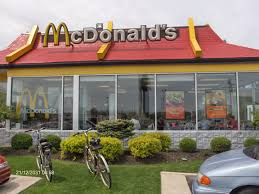A Communitarian Appreciation of McDonald’s

So I differ from many other non-libertarian conservatives by appreciating many of America’s huge national and multinational chain institutions, such as Walmart and Waffle House.
I was glad to discover in the NYT a sophisticated writer who appreciated McDonald’s. It’s not because of the food, which is mostly pretty bad. Well, the fries and the fish sandwich are both exceptionally tasty and won’t kill you if you only eat them once in a while. And, let’s tell the truth, none of us should be so snotty as to forget that McDonald’s provides an opportunity for struggling working Americans to take the family out to dinner at a very low price. Recently I was touched by seeing two very old couples—probably on a fixed income and all that—double-dating by getting ice cream at McDonald’s. The ice cream isn’t really ice cream, but you don’t notice that if you cover it with hot fudge, which may or may not really be hot fudge.
The calorie per dollar ratio at McDonald’s couldn’t be better, if you remember that the point of eating is to ingest calories. There is something perverse—contrary to nature—about paying $30 for some salad that has fewer than 300 calories, when you can get 1200 calories at McDonald’s for two bucks. My full stomach won’t believe you when you tell it they’re nothing but empty calories.
But the concern of the NYT article isn’t the food, but community: “All of us, of whatever age, need to socialize in public places to feel connected and alive.” Satisfaction of that human need is often particularly tough for old Americans—those retired and over 65. They’re often quite detached from family. The fastest growing demographic category, I’m told, is men over 65 without a spouse or close relationships with children. And, of course, they’ve been disconnected from the structured community that’s most workplaces. Fewer and fewer of them have secure “church homes.” Freud tells us that love and work are what make human life worth living, and many of these old guys don’t have much going on on either front.
So it might be best, as our author contends, if there were lots of locally owned diners and bakeries around serving as “de facto social centers” for our marginalized elderly. But such places increasingly fall victim to the realities of the 21st century marketplace. They’re taken out by chains—such as McDonald’s and Waffle House and Panera Bread.
The chains aren’t so bad, though. Check out your local McDonald’s, and you’ll probably find old guys lounging and talking the morning away drinking coffee. McDonald’s can really afford to be indulgent of their marginal contribution to the restaurant’s productivity. The “dining room” of a McDonald’s is typically huge and rarely filled. Most of the business is drive-up or take-out. A big point might be that McDonald’s actually can afford to be more indulgent than a locally owned coffee shop or diner, both of which find it much more difficult to turn a profit.
Panera Bread, where I am right now, has even figured that its niche is creating the fake family atmosphere with the fire place and all that. So my Panera is typically features older Americans hanging out, and, for that matter, Americans of all ages hanging out. The fake family devised in St. Louis morphs in the direction of a real family here in Georgia. But Panera has its limits on this front. It can’t quite be totally indifferent to customer turnover, and those in charge don’t really want you here all day. They want room for those coming to the dining room to each lunch, when most of their profit is made. McDonald’s, to repeat, has less reason to care. Panera, I hasten to add, has a very soft spot for the genuinely homeless or profoundly marginalized, and profit can’t explain THAT.
I’ve also noticed that smart and affluent old guys (who go to church and have loving families) in my Rome, GA sometimes develop a morning cycle of communal stops. They spend some time at Panera, go on to Steak and Shake, to a local restaurant called Troy’s to have a real breakfast, and then perhaps return to Panera to top the morning off. The cycle I can see with my own eyes doesn’t include McDonald’s, maybe because the McDonald’s guys are happy enough with their first stop.
Why haven’t I said anything about Starbucks? Well, our local Starbuck’s is a bit too claustrophobic, unless it’s warm enough to sit outside. More importantly, as I’ve said before: Starbucks coffee is terrible. McDonald’s is actually quite good, and it’s gentle enough to allow you to drink several cups without unpleasant effects.
It’s only because I’m out of time that I won’t go on to tell you about the breakfast—and especially about those who ingest the bountiful breakfast buffet—at the Dwarf House run by the highly profitable chain Chick-fil-A. The same with Dunkin’ Donuts, which has, everyone knows, coffee worthy of the name gourmet.
I will return to Waffle House (and Huddle House) on another occasion.




